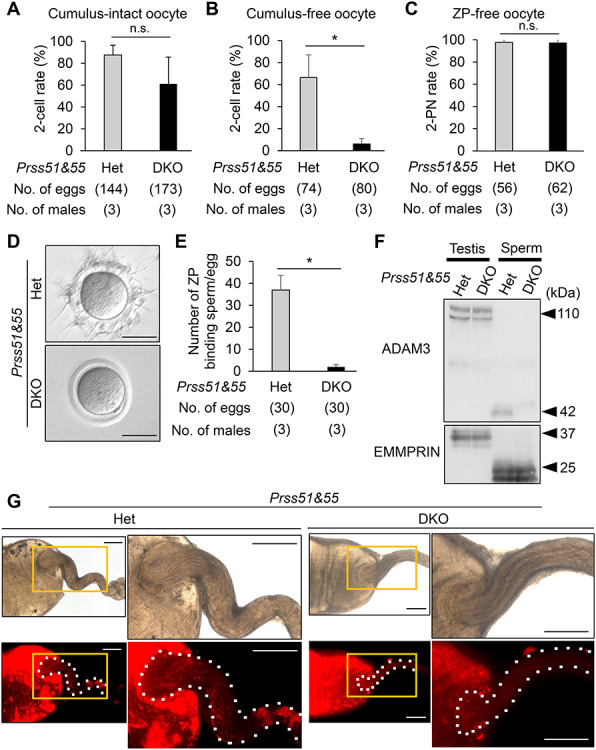Figure 3.

Phenotypic analysis of mouse spermatozoa lacking both Prss51 and Prss55. A. IVF rates (percentage of two-cell stage eggs) in cumulus-intact oocyte using spermatozoa derived from Prss51 and Prss55 heterozygous (Het) and homozygous (DKO) males. Average IVF rates of Het and DKO spermatozoa were 87.6 ± 8.9 and 61.1 ± 24.5%, respectively. N.s., no significance (P > 0.05). Error bars, mean ± SD. B. IVF rates (percentage of two-cell stage eggs) in cumulus-free oocyte using spermatozoa from Het and DKO mice. Average IVF rates of Het and DKO spermatozoa were 66.3 ± 20.6 and 6.0 ± 5.0%, respectively. *P < 0.05. Error bars, mean ± SD. C. IVF rates (percentage of two pronuclei [2PN] eggs) in ZP-free oocytes using spermatozoa from Het and DKO mice. Average IVF rates of spermatozoa from Het and DKO mice were 97.8 ± 3.2 and 97.1 ± 4.0%, respectively. N.s., no significance (P > 0.05). Error bars, mean ± SD. D. Sperm–ZP-binding assay. Spermatozoa from Het and DKO mice were used to inseminate cumulus-free oocytes. Scale bars, 50 μm. E. Average numbers of ZP-binding spermatozoa per total number of eggs in Het and DKO male mice were 36.9 ± 6.6 and 2.0 ± 1.1, respectively. *P < 0.05. Error bars, mean ± SD. F. Detection of ADAM3 by immunoblotting. EMMPRIN was used as a control. Testis, whole testis; sperm, cauda epididymal spermatozoa. Het, heterozygous; DKO, Prss51 and Prss55 homozygous DKO. Black arrowheads, molecular weights (kDa). G. Imaging of sperm migration through the female reproductive tract. Wild-type females were mated with Het and DKO mice carrying the RBGS transgene, in which spermatozoa exhibit green fluorescence (EGFP) in the acrosome and red fluorescence (DsRed2) in the mitochondria within the flagellar midpiece. Upper panels, bright-field images; lower panels, red fluorescence images. Boxed regions (orange lines) of each left image indicate areas shown in higher magnification of each right image. White dashed lines, areas from the uterus to oviduct. Scale bars, 1 mm.
